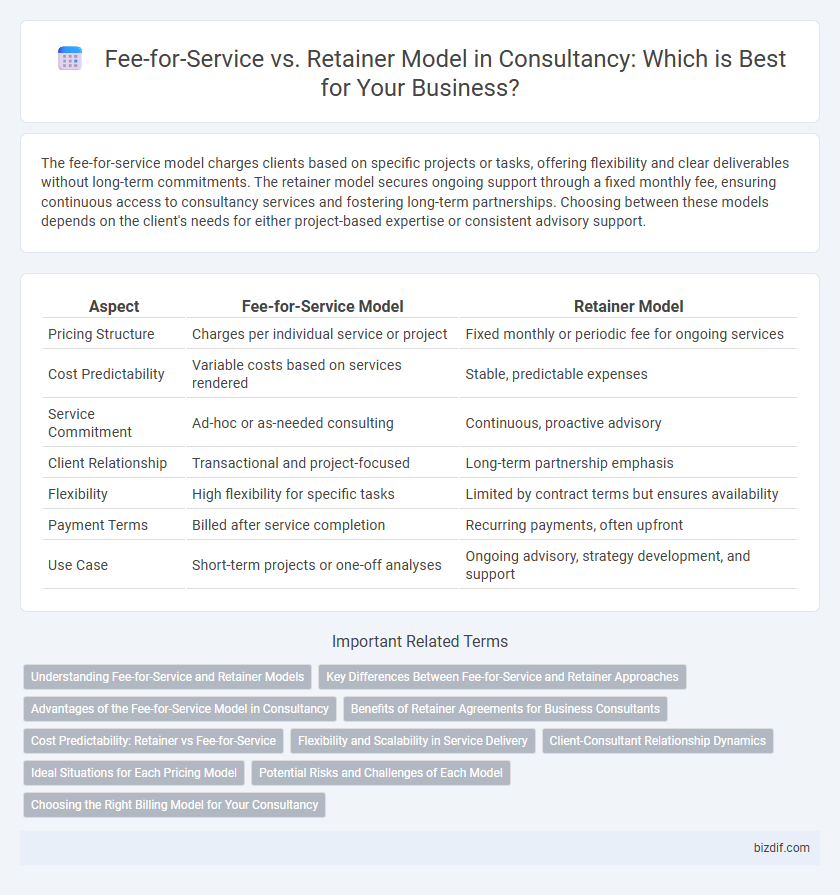The fee-for-service model charges clients based on specific projects or tasks, offering flexibility and clear deliverables without long-term commitments. The retainer model secures ongoing support through a fixed monthly fee, ensuring continuous access to consultancy services and fostering long-term partnerships. Choosing between these models depends on the client's needs for either project-based expertise or consistent advisory support.
Table of Comparison
| Aspect | Fee-for-Service Model | Retainer Model |
|---|---|---|
| Pricing Structure | Charges per individual service or project | Fixed monthly or periodic fee for ongoing services |
| Cost Predictability | Variable costs based on services rendered | Stable, predictable expenses |
| Service Commitment | Ad-hoc or as-needed consulting | Continuous, proactive advisory |
| Client Relationship | Transactional and project-focused | Long-term partnership emphasis |
| Flexibility | High flexibility for specific tasks | Limited by contract terms but ensures availability |
| Payment Terms | Billed after service completion | Recurring payments, often upfront |
| Use Case | Short-term projects or one-off analyses | Ongoing advisory, strategy development, and support |
Understanding Fee-for-Service and Retainer Models
Fee-for-service models charge clients based on specific deliverables or hourly work, offering flexibility and clear cost visibility for individual projects. Retainer models involve clients paying a consistent monthly or quarterly fee for ongoing access to consulting expertise, fostering long-term strategic partnerships. Understanding these models helps businesses align consulting services with budget preferences and project scope requirements.
Key Differences Between Fee-for-Service and Retainer Approaches
The Fee-for-Service model charges clients based on specific tasks or projects, providing clear cost transparency and flexibility for one-time engagements. In contrast, the Retainer model involves a recurring fixed fee, ensuring ongoing support and prioritized access to consultancy services. Key differences include payment predictability, scope of work flexibility, and the nature of client-consultant relationship, with fee-for-service suitable for discrete projects and retainers favoring long-term partnerships.
Advantages of the Fee-for-Service Model in Consultancy
The Fee-for-Service model in consultancy offers clear cost transparency by charging clients only for specific tasks or projects, ensuring budget control and minimizing financial risk. This model enhances flexibility, allowing clients to select services tailored to immediate needs without long-term commitments or ongoing fees. Consultants benefit from performance-based compensation, motivating the delivery of high-quality, results-driven solutions aligned with client objectives.
Benefits of Retainer Agreements for Business Consultants
Retainer agreements provide business consultants with predictable, steady income and strengthen long-term client relationships through ongoing support and strategic planning. This model facilitates deeper client understanding, enabling tailored solutions that drive sustained business growth and increased client satisfaction. Retainers also reduce administrative overhead and cash flow variability compared to fee-for-service arrangements.
Cost Predictability: Retainer vs Fee-for-Service
The retainer model offers superior cost predictability by establishing a fixed monthly or annual fee regardless of service usage, enabling clients to budget expenses accurately. In contrast, the fee-for-service model fluctuates based on the volume and complexity of work performed, increasing financial uncertainty. Businesses seeking stable financial planning often prefer retainers to avoid unexpected spikes in consultancy costs.
Flexibility and Scalability in Service Delivery
The Fee-for-service model offers high flexibility, allowing clients to pay only for specific tasks, making it ideal for projects with variable scope or short-term needs. The Retainer model provides more scalability by ensuring consistent access to consultancy resources over time, supporting long-term strategic planning and ongoing service delivery. Choosing between these models depends on a client's need for adaptable engagement versus stable, scalable support.
Client-Consultant Relationship Dynamics
The Fee-for-service model fosters a transactional client-consultant relationship characterized by project-specific engagement and clearly defined deliverables, promoting flexibility but potentially limiting long-term collaboration. The Retainer model establishes an ongoing partnership with continuous access to consultancy expertise, enhancing trust, strategic alignment, and responsiveness to evolving client needs. Clients benefit from stable budgeting and deeper consultant integration in business processes under retainers, whereas fee-for-service arrangements provide cost control tied to discrete projects.
Ideal Situations for Each Pricing Model
The Fee-for-service model is ideal for consultancy projects with clearly defined scopes, short-term objectives, or one-time deliverables, allowing clients to pay only for specific services rendered. The Retainer model suits ongoing advisory relationships, where continuous support, strategic guidance, and long-term collaboration are essential, ensuring consistent access to expertise. Selecting the appropriate pricing model depends on project duration, complexity, and client-consultant engagement frequency.
Potential Risks and Challenges of Each Model
In the Fee-for-service model, potential risks include unpredictable revenue streams and client disputes over scope and deliverables, which can strain consultant-client relationships. The Retainer model may lead to challenges such as underutilization of retained hours, creating inefficiencies and potential loss of client trust if expectations are not managed properly. Both models require clear communication and contract terms to mitigate risks like scope creep and payment delays.
Choosing the Right Billing Model for Your Consultancy
Selecting the appropriate billing model for your consultancy hinges on your project scope and client relationship dynamics. The fee-for-service model offers flexibility and precise cost alignment for project-based work, ensuring clients pay only for delivered tasks. In contrast, the retainer model guarantees steady revenue through ongoing engagement, ideal for long-term advisory roles and continuous support.
Fee-for-service model vs Retainer model Infographic

 bizdif.com
bizdif.com